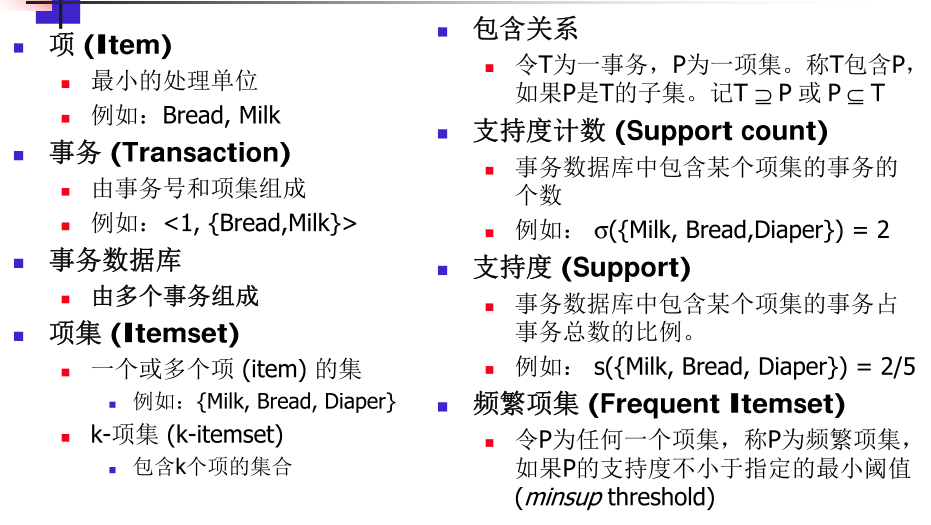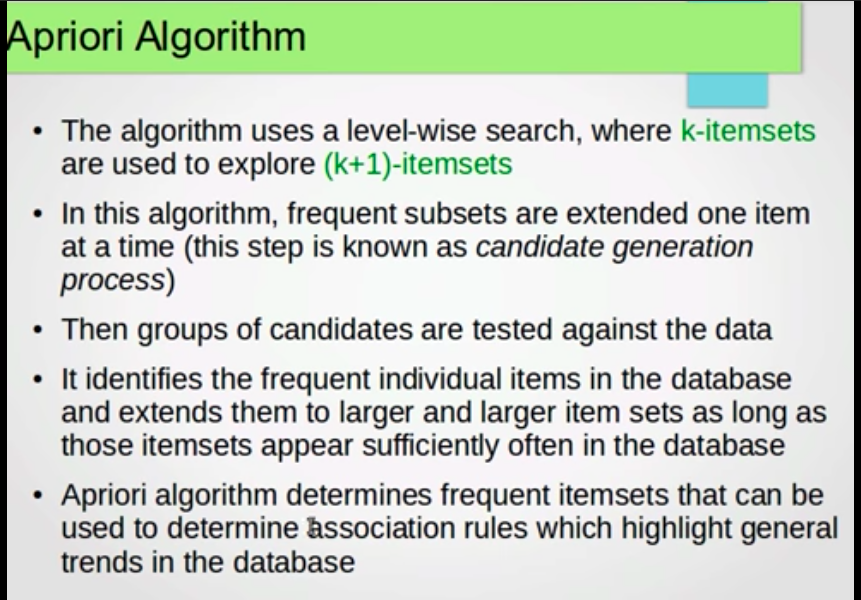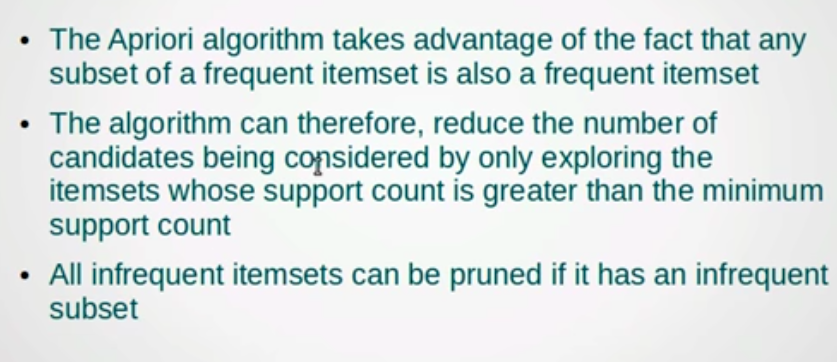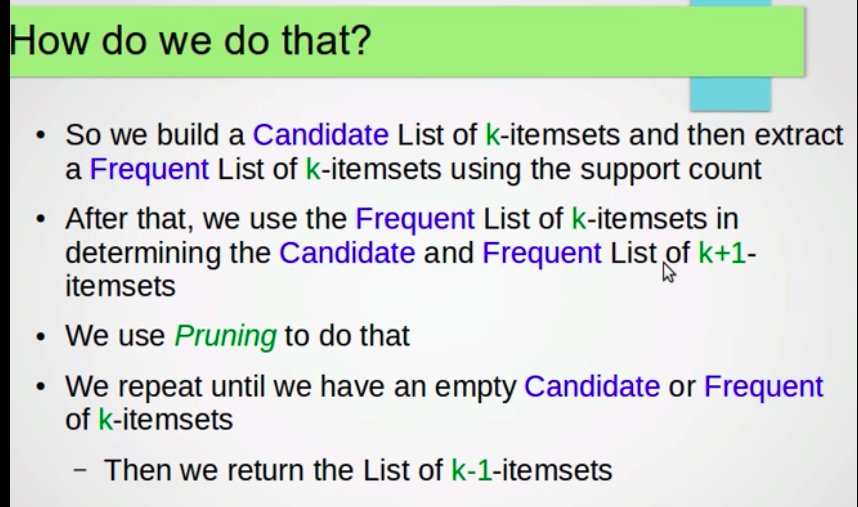An association rule is a pattern that states when an event occurs, another event occurs with certain probability. Association relus find all sets of items that have support count greater than the mimimum support; then using the large itemsets to generate the desired rules that have confidence greater than the minimum confidence. For frequent itemset mining, we use Apriori algorithm.
The following details are from The Apriori Algorithm … How The Apriori Algorithm Works.
Concepts
A set of all items in a store $I=\{i_1,i_2,…,i_m\}$
A set of all transactions (Transaction Database T)
$T={t_1,t_2,…,t_n}$
Each $t_i$ is a set of items s.t. $t\subseteq I$
Each transaction $t_i$ has a transaction ID(TID)
基本概念

Apriori Algorithm



Example
Say we have a transaction database and the minimum support count is $sc=2$.
| TID | Items |
|---|---|
| 100 | 1 , 3 , 4 |
| 200 | 2 , 3 , 5 |
| 300 | 1, 2, 3, 5 |
| 400 | 2, 5 |
| 500 | 1, 3, 5 |
Step One : 1-itemset
| Itemset | Support |
|---|---|
| 1 | 3 |
| 2 | 3 |
| 3 | 4 |
| 4 | 1 |
| 5 | 4 |
so we delete itemset = 4 because its support is less than 2, after prunning:
| Itemset | Support |
|---|---|
| 1 | 3 |
| 2 | 3 |
| 3 | 4 |
| 5 | 4 |
Step 2 : 2-itemset
we build 2-itemset based on 1-itemset, where we get {1,2},{1,3},{1,5},{2,3},{2,5},}{3,5}
| Itemset | Support |
|---|---|
| {1,2} | 1 |
| {1,3} | 3 |
| {1,5} | 2 |
| {2,3} | 2 |
| {2,5} | 3 |
| {3,5} | 3 |
delete itemset { 1,2 } because its support is 1.
| Itemset | Support |
|---|---|
| {1,3} | 3 |
| {1,5} | 2 |
| {2,3} | 2 |
| {2,5} | 3 |
| {3,5} | 3 |
Step 3 : 3-itemset
we build 3-itemset based on 2-itemset, where we get{1,3,5},{1,2,3},{1,2,5},{2,3,5}
Before counting each itemset’s support, we do some prunning.
For {1,3,5} : {1,3},{1,5},{3,5}, and according to the fact that any frequent itemsets’ subset must be frequent itemset, so {1,3,5} may be frequent itemset because all of its subsets are frequent itemset.
For {1,2,3} : {1,2},{1,3},{2,3}. Because {1,2} is not frequent itemset, {1,2,3} is not frequent itemset and we don’t need to calculate its support.
Same rule to {1,2,5} and {2,3,5}, we can say that {1,2,5} is not frequent itemset but {2,3,5} may be frequent itemset.
| Itemset | Support |
|---|---|
| {1,3,5} | 2 |
| {2,3,5} | 2 |
Step 4 : 4-itemset
we get 4-itemset : {1,2,3,5}.
Prune :{1,2,3},{1,2,5},{1,3,5},{2,3,5}. because {1,2,5} and {1,2,3} are not frequent itemsets, {1,2,3,5} is not frequent itemset.
Then we end up with empty. We return 3-itemset {1,3,5} and {2,3,5} for rule generation.
Association rule generation
Now we have the list of frequent itemsets
| Itemset | Support |
|---|---|
| {1,3,5} | 2 |
| {2,3,5} | 2 |
Generate all nonempty subsets for each frequent itemset $I$
- For {1,3,5}, we have {1},{3},{5},{1,3},{1,5},{3,5}
- For {2,3,5}, we have {2},{3},{5},{2,3},{2,5},{3,5}
For every subset $s$ of frequent itemset $I$, with the minimum confidence threshold, we generate the rule:
Let us assume the minimum confidence threshold is 60%,
For frequent itemset {1,3,5}:
- Rule1: $\{1\}\to \{3,5\}$, confidence = $\frac{sc\{1,3,5\}}{sc\{1\}}=\frac{2}{3}=66.66\%$ Selected
- Rule2: $\{3\}\to \{1,5\}$, confidence = $\frac{sc\{1,3,5\}}{sc\{3\}}=\frac{2}{4}=50\%$ Rejected
- Rule3: $\{5\}\to \{1,3\}$, confidence = $\frac{sc\{1,3,5\}}{sc\{5\}}=\frac{2}{4}=50\%$ Rejected
- Rule4: $\{1,3\}\to \{5\}$, confidence = $\frac{sc\{1,3,5\}}{sc\{1,3\}}=\frac{2}{3}=66.66\%$ Selected
- Rule5: $\{1,5\}\to \{3\}$, confidence = $\frac{sc\{1,3,5\}}{sc\{1,5\}}=\frac{2}{2}=100\%$ Selected
- Rule6: $\{3,5\}\to \{1\}$, confidence = $\frac{sc\{1,3,5\}}{sc\{3,5\}}=\frac{2}{3}=66.66\%$ Selected
Same operations on {2,3,5}.